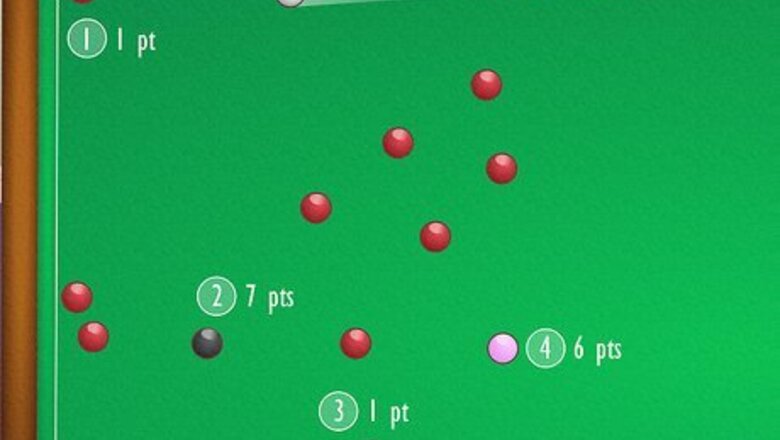
views
- Play snooker with a set of 15 red balls, 6 colored balls, and a white cue ball. Arrange the balls in their starting spots on a snooker table.
- Alternate between shooting at red balls and colored balls with the cue to earn points. Each color is worth a different number of points between 1–7.
- After all the red balls have been pocketed, shoot the colored balls in ascending point order. Whoever has the most points when there are no more balls wins the game.
Objective
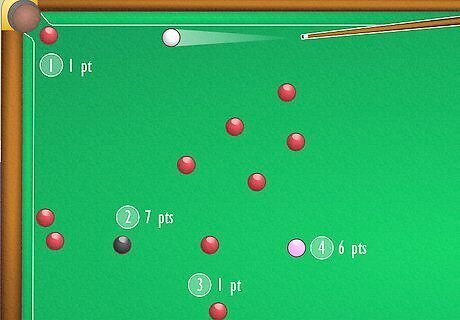
Earn points for shooting balls into the table’s pockets in the correct order. In snooker, players strike a white cue ball to hit the red or colored balls into the pockets in the corners and sides of the snooker table. Players must alternate between hitting the red balls and the various colored balls with each shot, and each ball color has a point value that adds to their score. By the end of the game when all the balls have been pocketed, the player with the most points becomes the winner. Even though snooker looks similar to pool or billiards, it has some slight differences. A snooker table is larger than a standard pool table, but the balls and pockets are smaller to make it a little more challenging.
Snooker Setup
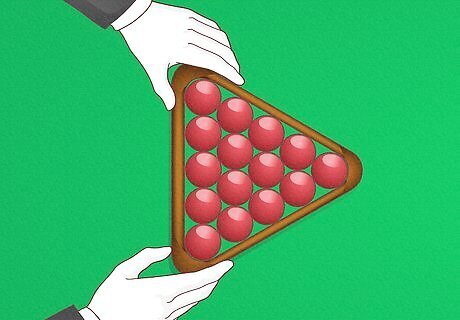
Rack the red balls in a triangle on the pyramid spot. Arrange the 15 red balls inside of a snooker rack so they form a triangle. Position one of the points of the triangle on the pyramid spot located on one end of the table. Remove the rack carefully so the balls stay tightly packed together. Snooker balls are slightly smaller than standard pool balls, which makes them a little more challenging to hit and line up shots.
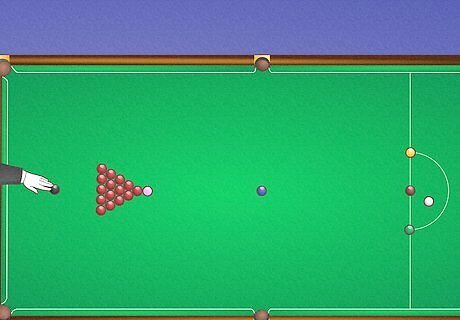
Place the colored balls on their matching spots on the table. Snooker tables are slightly larger than standard pool tables and have specific starting places marked for each of the 6 colored balls. Place the pink ball on the pink spot just in front of the racked red balls, and put the black ball on the spot a few inches behind them. Set the blue ball in the spot at the center of the table. Then, place the green, brown, and yellow balls on their matching spots along the baulk line on the opposite end of the table. Even though a snooker table is a little larger than a regular pool table, the pockets are smaller so it’s a bit more difficult to sink a ball.
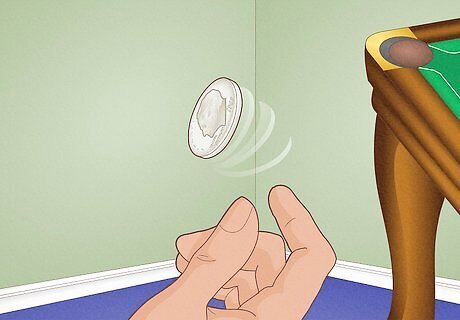
Flip a coin to determine the first player. Snooker is typically a 2-player game, but you can play with 4 people split into teams of 2. Flip a coin or use any other method of choosing who will start the game and play their first turn, also known as a “break.”
Gameplay
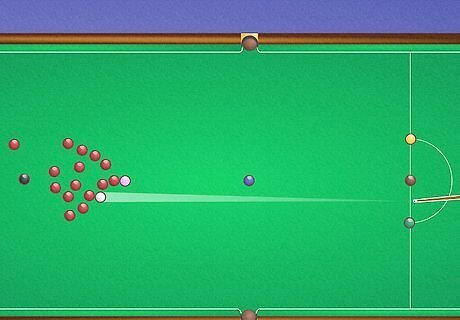
Shoot the cue ball at the red balls from inside the D to start the game. The D is the semi-circular area behind the baulk line on the snooker table. The starting player may place the white cue ball anywhere inside or along the lines of the D to line up their first shot. The player then lines up the shot with their cue to hit one of the red balls. If the player sinks a red ball on their first shot, then they continue their turn. If the cue ball touches a colored ball before a red one, then the shot is considered a foul. After the first turn, players must hit the cue ball from where it comes to rest on the table. The only other time players can move the cue ball before their shot is if it went into one of the pockets or came off of the table. Unlike in a game of pool, where the goal is to scatter the balls across the table on a break, try to be conservative for a snooker break. When the balls are closer together, your opponent will have a more difficult time shooting at the correct ball.
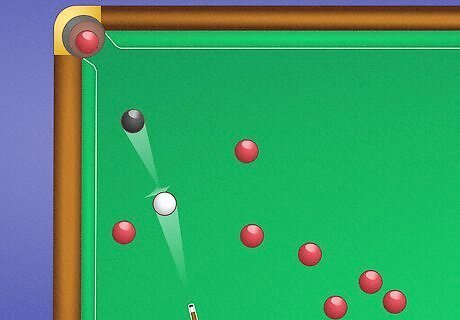
Alternate between shooting red and colored balls during a turn. On the first shot of a turn, the red balls are considered “on,” so a player must hit one of them with the cue ball to shoot it into a pocket. If they sink (or “pot”) a red ball, they then choose any of the colored balls as the next one “on” to aim at for their next shot, leaving the cue ball where it came to rest. As long as a player pockets the correct ball color with each shot, they continue taking their turn. If a player misses their shot or hits a ball color that’s not “on,” then their turn ends. If a player scratches, which is when the cue ball goes into one of the pockets, or if the player sinks a ball in the wrong order, it’s considered a foul. If the red balls are “on,” it’s okay if 2 or more balls are pocketed in the same turn. However, pocketing 2 balls of different colors on any turn results in a foul.

Score points based on the value of the ball that’s potted. Whenever a player pots a ball that’s “on” during their turn, they add the ball’s value to their score. Players can mentally keep track of their scores, or write them down on a piece of paper. The values of the ball depends on the color and are as follows: Red: 1 point Yellow: 2 points Green: 3 points Brown: 4 points Blue: 5 points Pink: 6 points Black: 7 points
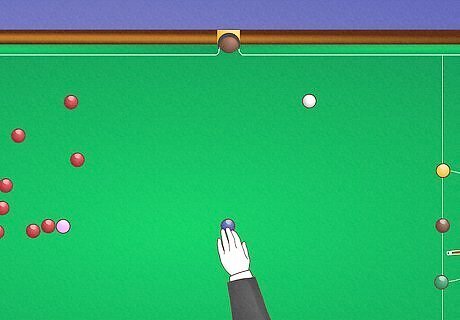
Replace colored balls on their spots after they’re potted. Once a red ball has been potted, it stays off of the table for the rest of the game. Whenever a colored ball goes into the pocket, whether it was “on” or incorrectly hit as a foul, the ball gets replaced on its matching spot on the table. If another ball is in the way or already on a spot for a colored ball, then place the colored ball on the colored spot of the next highest point value. For example, if the green ball was potted but another ball got knocked onto the green spot, place the green ball on the brown spot instead. If all of the spots are occupied, just place the ball as close as possible to its starting position.

Switch players whenever someone misses a shot or commits a foul. As soon as a player takes a shot without hitting or potting the “on” color, their turn immediately ends. The player earns all of the points from the balls they potted during their turn, and the next player starts their turn with the red balls “on.” Common fouls in a game of snooker are: Hitting a ball other than the cue ball with the cue Hitting a ball that’s not “on” first with the cue ball Hitting the cue ball more than once during a stroke Hitting a ball while any ball on the table is still moving Hitting a jump shot so the cue ball leaves the table Pushing the cue ball after initially hitting it Playing out of turn In competitive snooker games, an opposing player may be rewarded penalty points after you commit a foul.
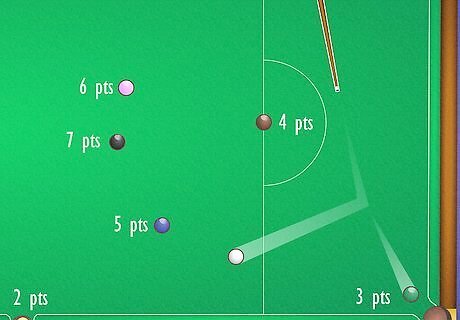
Sink the colored balls in point order after potting all the red balls. After all of the red balls have been pocketed, players close out the game by consecutively sinking the remaining colored balls in order of their point value from lowest to highest. Once a colored ball has been potted at this point in the game, they’re not put back in their original positions. Once all the balls have been potted, then the game ends. The correct order for potting the colored balls at the end of the game is yellow, green, brown, blue, pink, and black.
Winning

Win a game by earning the most points after the last ball gets potted. After the black ball gets potted at the end of the game, add up the points that each player earned throughout the game. Whoever received the most points from potting balls and earning penalty points is the winner! If you want to play a competitive match of snooker, reset the table and play another match. Whoever does the best for 2 out of 3 games or 3 out of 5 games is considered the winner. If a player doesn’t think they can catch up to the other person’s score, they may concede the game earlier. If the scores are tied, the black ball is placed on the table on its starting spot. Players take turns shooting the cue ball at the black ball. The first player that can pot the black ball is the winner.
Improving Your Snooker Game
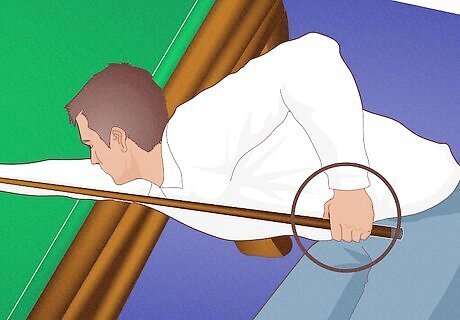
Use a proper grip and stance to get the most power and accuracy. Hold the cue near the bottom of the thick, weighted end with your dominant hand. Move your hand closer to the end of the grip to gain more control and extension for your shots. Lay your non-shooting hand on the table and use it as a bridge to support the front of your cue. Keep your dominant leg straight and lean forward when you make a shot so the cue is parallel to the table. Common ways to rest your cue include the “open bridge,” where you place your cue in the groove of the thumb joint, or a “closed bridge,” where you make a circle with your thumb and pointer finger and rest the cue inside. Lift the bottom of your hand off the table to raise the end of the cue so you’re able to get a better aim at balls that are close to the rails or other balls.
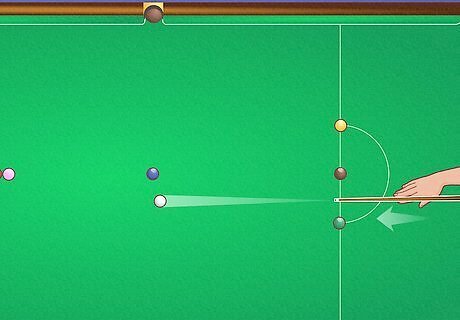
Move the cue in a smooth, straight line when you shoot. In one tight, controlled motion, draw your shooting arm back a few inches and thrust it forward, hitting the cue ball in the upper part of its center. Keep your elbow relaxed and close to your side throughout your shot to keep control over the ball. Try to make your movements as fluid as possible because a jerky or halted stroke may lose accuracy. Practice shooting straighter by bouncing the cue ball off one of the rails and seeing how closely it returns to the tip of your cue. Adjust where you hit the cue ball to correct your aim. Take a brief pause before moving the cue forward to help make your shot more accurate.
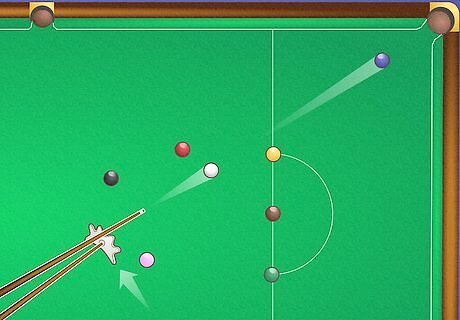
Use cue rests to steady your cue during difficult shots. If you have trouble lining up a shot because balls are cluttered together or if you’re reaching onto the table, an arched rest piece attaches to the end of another cue. Set the rest on the table, and then fit your cue into the rest to support it.
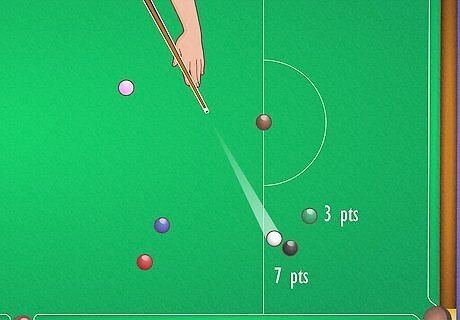
Aim for the colored ball that has a clear shot and earns the most points. After you sink a red ball, check which colored balls are nearby and have an open shot. Choose one of the balls with a higher point value if you’re able to so you can maximize your score. Remember that the colored balls get re-spotted on the table after they’re pocketed, so you can score them multiple times. The fixed position of the colored balls means you should always have a clear shot at one, no matter where the cue ball is on the table.
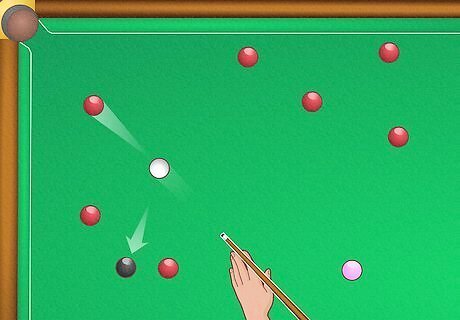
Aim for red balls that put you in a good position to hit a colored ball. As you assess the table for your shot, look for a red ball that will leave you with a follow-up shot at one of the colored balls. Keep in mind the value of each ball and go for the ball that will earn you the highest number of points whenever you can. Try to use enough power on your shot so the cue ball comes to a stop near the center of the table so you have an unobstructed follow-up. The ability to use one shot to set up the next is the hallmark of a skilled snooker player. Avoid taking risky shots that could make you miss the ball or commit a foul. Look over the entire table and determine what your best option is before trying to pocket a ball at a distance or angle you’re not sure you can make. Try to stay away from making shots at sharp angles or bank shots that bounce off the side rails. The small size of the snooker pockets makes it more difficult to accurately hit these shots.




















Comments
0 comment